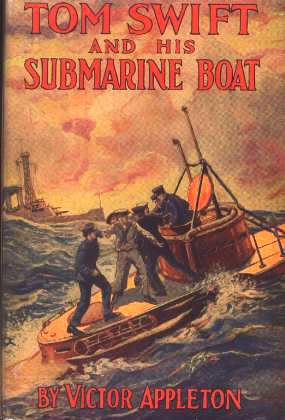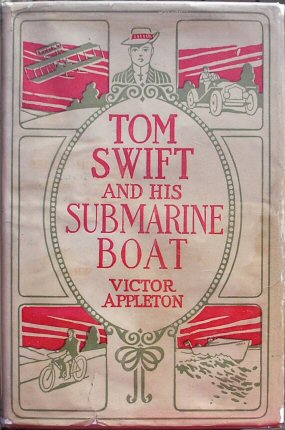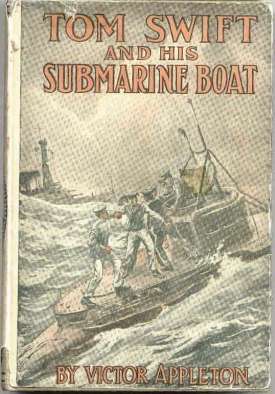
Tom Swift and His Submarine Boat
or, Under the Ocean for Sunken Treasure
By Victor Appleton Book #4 ©1910
Review by JP Karenko, May 2005
White Quad Dustjacket is from the collection of Mark Snyder.
Note: some of the language, references & attitudes, while acceptable at the time they were written, are not Politically Correct, today.
Summary: No official summary was ever provided with any of the old Tom Swift books. However, without giving too much away, the plot can be summed up as follows:
The book opens with Barton & son trying to complete Barton's prototype submarine in a shed on the New Jersey shore for a government competition. The winner would get a prize of $50,000. When word is received of a shipwreck off the Uruguayan coast, plans get changed. The steamer Boldero is carrying $300k in gold and has sunk at a depth of nearly 3 miles, far below the ability to reach with current submarine or diving technology. The Advance, the Swifts' new sub can dive that deep, and a new hard shell diving suit carried by the sub, can work outside at the 15k foot depth.
A rival sub building firm catches wind of the treasure hunt, and plans are laid to purloin the sunken gold. Two near-fatal incidents mark the sub's completion and shakedown cruise, but all obstacles are overcome (you expected otherwise?) and the voyage begins.
The B&E boat tracks the Advance, and an underwater battle ensues. You'll have to read the rest of the story to see how it ends.
This book is available online. See: Tom Swift and His Submarine Boat
![]()
Cast of Characters (More or less in order of appearance)
 Barton Swift-Widower. Wealthy and conservative. Not flashy or pretentious.
Inventor master machinist and holder of numerous patents. In this episode,
described as "aged," "nervous," "distracted" and "feeble."
Barton Swift-Widower. Wealthy and conservative. Not flashy or pretentious.
Inventor master machinist and holder of numerous patents. In this episode,
described as "aged," "nervous," "distracted" and "feeble."
Mrs. Baggert-Housekeeper. Kindly, and "loves Tom like a son." Employed by the Swift family since the time Tom's mother died. She is short of stature and has to stand on a soap box to kiss Tom goodbye on one of his voyages.
Tom Swift-Intrepid inventor & mechanic. Plucky, lively, resourceful, brave and clever. Home-schooled at a college level by his father, Barton Swift. Athlete and hunter. Familiar with how to stalk game and firearms. Loves all things mechanical. Is a decent cook, too.
John Sharp-Professional balloonist and trapeze artist. Rescued by Tom when his hot-air balloon gets a bit too hot and burns. Deputy Sheriff as a sideline. Co-designer with Tom, of the Airship, Red Cloud. Tall, thin and 'dark' of complexion, he seems to now have given up speaking in short, choppy sentences, as in the 1st three books. "In residence" with the Swift family, has become sort of hands and feet for Tom's father.
Addison Berg -- Representative of Bentley & Eagert (B&E), a Philadelphia submarine builder. Industrial spy and all-around bad guy. Hires Andy Foger to cause trouble for Tom.
Garrett Jackson -- Aged (65+ years old) "engineer" who is more handyman/machinist and watchman type. Resides on Swift estate.
Andy Foger-Red haired, squinty-eyed bully, who makes great trouble for Tom. "Poor little rich kid," son of wealthy family, born with a chip on his shoulder. Reckless, blustery and angry. Showoff. "Has money, and not much else." Lately has upped ante to attempted murder when he traps Tom in an airtight compartment and leaves him to smother.
Mr. Foger -- NFN given. Passing mention that he is on the Board of Directors of B&E.
Eradicate Andrew Jackson Abraham Lincoln Sampson, A.K.A. Rad-Aged stereotypical Negro journeyman jack-of-all-trades. "Eradicates dirt." Gives the appearance of being lazy, but is actually a hard worker and entrepreneur/wheeler-dealer. Heavy deep-south accent and Uncle Remus attitude. Caretaker of mule Boomerang. In this tome, is limited to acting as estate watchman while the Swifts are voyaging.
Sam Snedecker-Cohort of Andy Foger. Voice of reason to Andy's scream of rage. No description given. Could be an OK guy if he were to stop associating with Andy Foger.
Pete Bailey-Cohort and willing minion of Andy Foger. No description given. Generic bad guy.
Ned Newton-Chum & companion of Tom, currently employed in Shopton National Bank. Ned has only a passing role in this tome.
Mr. Wakefield Damon-Elderly & eccentric adventurer whose main purpose in life seems to be blessing everybody and everything near his person. In this episode, he is "fond of good living." He had graduated from cycles to automobiles. In spite of ongoing trouble mastering most any conveyance he tries to control, has successfully piloted an airship.
Mr. Maxwell - NFN or description given. Minion of Addison Berg.
Mr. Bentley - NFN or description given. Bentley of Bentley & Eagert Subs Inc. Employer of Addison Berg. Bad guy.
Unnamed Hotel Clerk -- Walk-on part. Single characteristic noted was a pinkie ring "with a large diamond." Hotels must pay well on the Jersey shore...
Captain Alden Weston -- Soft-spoken and mild mannered sea captain hired by Swifts to navigate their sub to the South Atlantic. World traveler and soldier of fortune. Described as smooth of face and with merry blue eyes. Main characteristic is diffident, self-effacing language. Ends nearly every sentence with "if you don't mind" or "if I may say so" or variations of same.
Admiral Fanchetti -- NFN or description given. Commander of Brazilian cruiser San Paulo. Much absorbed with gold braid and bluster. Also able to leap to false conclusions with a single bound. Adept at passing out death sentences.
Lieutenant Drascalo - NFN or description given. Fanchetti's hatchet-man, possibly XO. A one trick pony in that his dialogue is pretty much limited to shouting "Silenceo!" at every opportunity. Even the author makes note of this annoying trait...
![]()
Major Inventions
Tom Swift didn't really invent anything in this book. The submarine design was entirely his father's idea. He did use some of the things he invented in the past (such as his Airship), but other than some suggested "improvements" to the sub's details, and an impromptu "anti-clog device" made for a water valve, he didn't really invent anything new in this tome.
Barton Swift's sub itself would be a wonder, even today. At 100ft length and 20ft beam, it is a massive undertaking for an individual builder, even of the Swifts' renown. A total of 6 people supposedly constructed this machine. A similarly-sized boat was listed in The Wonder Book of Knowledge © 1921 as displacing about 170 tons, submerged. The hull is described as triple layered, with a secret material sandwiched between the plates for added (crush) strength. It is able to remain afloat even with 3 of its many compartments flooded. It is also reputed to be able to remain submerged for 30 days or more. No top speed is given, except to describe it as "speedy." Based on a 3-day cruise to Bahama from NJ, (about 1000mi, straight-line) projected sustained speed of the Advance was calculated to be 14mph (12kt), a significant improvement over the 8-9kt maximum speed of "modern" subs of the 1920's. Layout is nearly today-modern, with a pilot house and conning tower forward, instead of amidships. Instrumentation, however, was suicidally basic. A compass, a depth meter and a speed indicator were it. Guidance was via an underwater searchlight, portholes and Mark One Eyeball. Proceeding aft, we find a luxurious lounge/mess room and galley. Further aft amidships, is the engine room and mechanical equipment areas. Behind the engine room are the sleeping quarters and storage areas. Propulsion is by a combination of "gasolene" engine (see errata) and motor dynamos, driving standard screws (for emergency only) and a new electrical hydrodynamic drive engaged through "peculiar plates" mounted on the bow and stern. An expandable lifting bag can be deployed for emergency floatation. A 6-seat electric launch is carried in a nest on the top deck for shore party use. The sub mounts 1 each "electric cannon" (much like today's rail guns) mounted fore & aft on swivels. These fire a 25 pound solid shot and were intended to repel "sea monsters." A standard ram is also mounted on the prow. The boat also has an airlock to deploy the hard shell diving suits.
The diving suits are all-metal, and require no air hoses or safety lines. Breathable environment is provided by "automatic air tanks." Jacques Cousteau may have read this tome as a youth and got the idea for modern SCUBA gear from it.
![]()
Commentary on Society, Attitudes, Environment & Errata
It's amazing how much society and technology have changed in 95 years. Reading the old Tom Swift Sr. series has really given me an appreciation of all the modern gadgets that I've come to take for granted. It also gives me an appreciation as to how much society has changed, too. I wonder what people will be taking for granted 100 years from now, and what they will think of our times? I believe Robert Heinlein put it best when he described our times as "The Crazy Years."
 Attitudes and Prejudices-Racing
for money used to be bad. Now, competing for government prize money is OK.
Keeping a loaded rifle around to deal with intruders seems to be OK. Even after
a near-fatal run-in with Andy Foger, Tom prefers to deal with him, personally,
rather than involve the police. Only certain telephones seem to have long
distance capability, and these are not common. Trolleys are used in Atlantis,
which leads me to suspect Atlantic City (sizeable, even in 1910) was used as a
model for this fictional town.
Attitudes and Prejudices-Racing
for money used to be bad. Now, competing for government prize money is OK.
Keeping a loaded rifle around to deal with intruders seems to be OK. Even after
a near-fatal run-in with Andy Foger, Tom prefers to deal with him, personally,
rather than involve the police. Only certain telephones seem to have long
distance capability, and these are not common. Trolleys are used in Atlantis,
which leads me to suspect Atlantic City (sizeable, even in 1910) was used as a
model for this fictional town.
Americans are described as "filibustering dogs," and Brazilians are referred-to as "brown-skinned villains, scoundrels and rascals." Pretty strong language, even for the day.
The oceans are free -- More like a free-for-all, by what is gotten away with in this tale. Much ado is made of unnamed "rights," and high-handed behavior seems the order of the day, while on the high seas. The B&E sub tries to crash Tom's boat from behind during their race. (Is this the forerunner of the Dale Earnhardt "bump?") Tom fires on them with his cannon "in self defense," and disables them, leaving them adrift. This is apparently OK, as "they started it." A Brazilian warship boards and tries to confiscate (as in steal) the Advance, and captures Tom & his companions. They are imprisoned, tried for piracy and sentenced to death. This is because they are in an armed craft and showing no flag. No evidence. Might Makes Right, y'know...
Errata- Where to begin??? Porpoises were observed at a depth of 5000ft. According to findings published in Diving and ranging behaviour of odontocetes: a methodological review and critique by SASCHA K. HOOKER and ROBIN W. BAIRD, Department of Biology, Dalhousie University, Halifax, Nova Scotia, B3H 4J1, Canada Mammal Rev. 2001, Volume 31, No. 1, 81--105 , the maximum depth recorded was 250m. (~750 ft.) (The Internet is a wonderful place...)
Later in the story, giant sharks are encountered at a depth of 13,000ft. Again, the author blew it, as the deepest diving shark is the basking shark. Some of their dives were VERY deep, and go from the surface to over 850 m depth over a matter of hours and back again That is the deepest vertical range of any shark yet measured. (Nowhere NEAR the 2-1/2 mile depth in the story.) Sims, David W. Threshold foraging behaviour of basking sharks on zooplankton: Life on an energetic knife-edge? Proceedings of the Royal Society of Biological Sciences, Series B. 266(1427):1437-1443; 1999.
Tom disassembles a blocked ballast control valve during the shakedown and clears it without flooding the compartment. The sub has to have been a maze of shutoffs, but they are never mentioned.
During the shakedown, the sub is doing a speed run in 65ft of water. Even if the top speed were only 20kt, with no sonar and only a compass and depth gage, this would be suicidal. Shoals abound off the Jersy shoreline. Water deeper than 150 ft is 50+ miles offshore.
Engineering and Science, Fact vs. Fantasy- In this volume, it is apparent that some additional limits of the scientific knowledge of the author(s) have been revealed.
Gasoline engines (the prime mover in subs of the day) were discarded shortly after 1910 in favor of Diesels due to the explosion hazard. Advance still uses not only a gas engine, but one that can be run underwater for days at a time. The volume of air ANY internal combustion engine uses precludes running it submerged, unless sub is just below the surface using a snorkel. Even with an unlimited air supply, the exhaust would have to be ejected into the water or the boat would become inflated like a balloon. The trail of bubbles should be impressive.
The magical hydrodynamic drive is explained as using the same principle as magnetic poles to both attract and repel seawater, the bow of the Advance was charged negatively and the aft plate positively through "peculiar plates." Those plates sound like a great way to generate Hydrogen gas at one end of the boat and Oxygen at the other. Little spark, big noise, no sub.
Barton Swift and John are both shocked (Barton into unconsciousness) by the malfunctioning dynamo on the Advance. In spite of receiving "the majority of the current," neither is permanently harmed due to the "low voltage." As little as 10mA will stop a heart and DC is particularly nasty stuff with as little as 24v being potentially lethal. Good luck or poor writing?
The electric cannon sounds like a good idea, but getting solid shot to go any distance under water is a losing proposition, due to water's density. That is why torpedoes carry a propulsion system on board. It is needed to overcome the drag as the projectile passes through the water over any distance.
Any naval commander who allows a capital ship to get caught in shallow water during a gale has to be incompetent, brain-dead or a political appointee. I suspect Admiral Franchetti may be all of the above. Besides, since when do "admirals" command something as piddly as a cruiser??? This popinjay's next command should be a rubber duck in a bathtub, or maybe a set of cement overshoes.
Finally, Tom uses a special code "47" to signal distress. I guess Sam Morse's code developed in 1844 and a simple CQD or SOS wouldn't do the job. In 1904, the Marconi company suggested the use of "CQD" for a distress signal. Although generally accepted to mean, "Come Quick, Danger," that is not the case. It is a general call, "CQ," followed by "D," meaning distress. A strict interpretation would be "All stations, Distress." At the second Berlin Radiotelegraphic Conference in 1906, the subject of a danger signal was again addressed. Considerable discussion ensued and finally SOS was adopted. The thinking was that three dots, three dashes and three dots could not be misinterpreted. It was to be sent together as one string. This signal was officially adopted in the US in 1908, after much foot-dragging. As an aside, Titanic used both calls while sinking.
Geography- "Atlantis, NJ" is a resort town, nearest to where the Swifts have set up seaside operations. Shopton is "one day's flight" from that seaside base. The Red Cloud is now capable of 90mph top speed, and if an 8 hour trip is stipulated at a normal cruise speed of 40-50mph, that puts it about 400 miles north of the Jersey shore. A check of DeLorme map software shows a straight line distance from Atlantic City to Burlington, VT ( near where I speculate "Shopton" is located) to be 350 miles.
Grand Bahamas Island is about 1000 miles from that part of Jersey, and since the Advance has a cruising radius of "about 250 miles per day," that bodes well for the 12kt sustained speed of the boat. On the other hand, the 45S Lat and 27E Long wreck location is MUCH further than the approximate 6-day voyage from Bahamas as stated. This is in addition to having to put up with bad guys, warships and sea-monsters. (An "octupus" <sic> tries them on for size on p194 and gets the en brochette treatment with the prow ram.)

As to the location of the wreck, the longitude is stated as 27E from Washington DC ( which is located 75W from Prime Meridian.) This would put the wreck somewhat near to the SA coast, but still a long way out. Water depth is charted as up to 13,000 feet. All this means the wreck location could be plausible, and just deep enough for the 2-1/2 mile depth stated in the book.
JP Karenko 5/2/05
![]()
Tom Swift and His Airship | Tom Swift and Electric Runabout | Index